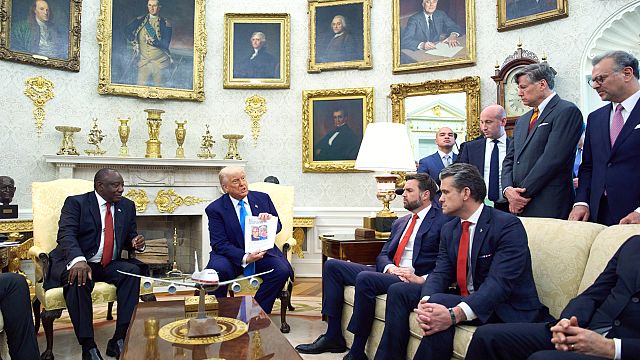In a dramatic Oval Office meeting between President Donald Trump and South African President Cyril Ramaphosa, a contentious video presentation sparked heated debate and raised eyebrows both within the room and beyond. The White House defended the video, claiming it depicted burial sites of white farmers who had fallen victim to persecution and violence in South Africa. However, the authenticity and intent behind the video stirred a whirlwind of controversy.
As the video played, showing crosses symbolizing slain white farmers, the atmosphere in the room became tense. Trump, unwavering in his assertions, pointed to the screen, emphasizing the plight of white farmers in South Africa. Ramaphosa, on the other hand, distanced himself from the allegations of systematic persecution, instead emphasizing the country’s painful history of racial tensions.
The clash of narratives highlighted deeper issues of racial dynamics and historical injustices in South Africa. The scars of apartheid, a system of racial segregation that plagued the nation for decades, still linger in the collective memory. The transition from apartheid to democracy marked a significant but challenging period for the country, with reconciliation efforts ongoing.
Expert analysis sheds light on the complexities underlying Trump’s actions and statements. The portrayal of white farmers as victims of targeted violence intersects with broader political agendas and narratives. Allegations of a genocide against white South Africans, unsubstantiated by evidence, fuel divisive rhetoric and perpetuate fear and mistrust.
The video’s imagery, juxtaposing anti-apartheid chants with rows of white crosses, symbolizes a clash of historical narratives and contemporary realities. The power dynamics at play, both within the Oval Office and on the global stage, reflect deeper tensions around race, identity, and power.
Beyond the immediate controversy lies a broader discussion on the impact of misinformation and inflammatory rhetoric. The manipulation of historical grievances for political gain underscores the need for responsible discourse and fact-based dialogue. The intersection of race, politics, and media narratives shapes public perceptions and influences policy decisions.
In conclusion, the clash over the video shown to President Ramaphosa encapsulates a multifaceted narrative of historical legacies, political posturing, and media manipulation. As societies grapple with the complexities of their past and present, the need for nuanced understanding, empathy, and dialogue remains paramount. The incident serves as a stark reminder of the power of storytelling, the dangers of misinformation, and the enduring quest for truth and reconciliation in a divided world.
Originally reported by Africa News
Read more at: http://www.africanews.com/2025/05/23/trump-defends-video-shown-to-south-african-president/

